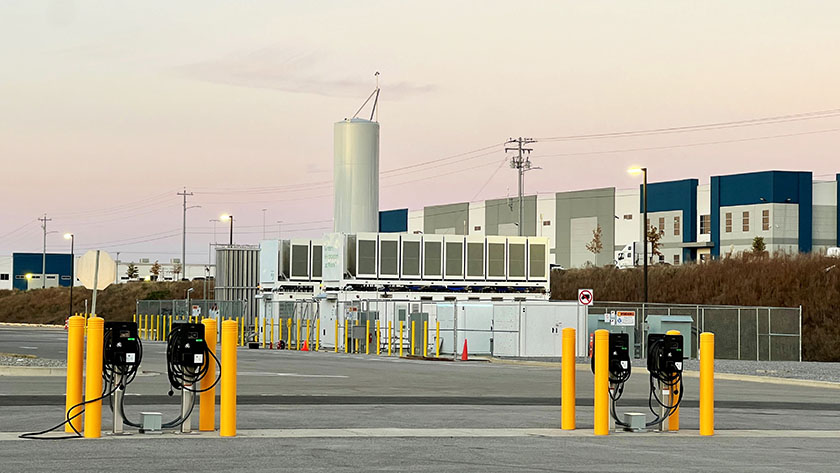The Hydrogen Revolution: Reliability, Sustainability, and Grid Stability
The US is currently facing challenges that test our electrical infrastructure’s resilience, stability, and security. Aging equipment, extreme weather conditions, and an increase in power demand require an innovative and transformative solution. Hydrogen-powered fuel cells are a proven technology that can provide power where and when needed to solve these problems.
Providing Power in High-Risk Fire Zones
In recent years, wildfires have become an alarming concern, partly due to electrical transmission lines. These lines, still the standard for electricity transmission, are increasingly identified as a significant cause of wildfires or a distribution weakness to essential services during a wildfire. This situation raises a pressing question: how can we decrease the chance of starting a wildfire from transmission lines and maintain power to essential services within a community?
This is where hydrogen-powered fuel cell power systems can step in. They provide clean, reliable, and (most importantly) safe power generation downstream of these transmission lines that can be dangerous or a distribution weakness. This technology ensures that utilities can continue to meet the power needs of their customers, without compromising safety.
Charging EV Fleets in Grid-Constrained Locations
Regulatory mandates and public sentiment are pushing commercial businesses to adopt greener practices, including switching their fleets to electric vehicles. However, the power needed to charge those EVs is immense and multiplied out across many fleets will deem it a substantial burden. In some locations, the grid updates needed to provide the power to charge EVs can take years, cost millions of dollars, and inevitably result in high or unpredictable utility bills. What’s worse is that power isn’t guaranteed to be renewable so EVs could be charged by fossil-fueled power.
Fuel cells powered by green hydrogen can provide sustainable on-site power generation for any site that can’t get enough energy from the grid. These fuel cells can be commissioned in a matter of months, instead of the years needed for a utility line extension. They can act as the permanent solution to charge EVs, or as a temporary solution to charge EVs while waiting for the grid to update, thereafter switching to a role for backup, demand response, or peak shaving. These fuel cells can also scale so as an electric fleet grows, or more site equipment electrifies, fuel cells’ modular design can meet the increasing power demand.

Grid Firming for Renewable Energy
The need for renewable energy sources like wind, solar, and hydro has never been more apparent. These sources offer a sustainable path to reduce carbon emissions and combat climate change. However, their intermittent nature presents a significant challenge to grid stability. Solar power generation demands consistent sunlight, and wind power relies on the presence of wind.
These forces, while potent sources of clean energy, are unpredictable and often out of sync with our energy demand patterns. What happens when clouds obscure the sun for extended periods, and winds are calm for days on end? The result is a potential gap in energy supply that can lead to power outages or force utilities to rely on fossil-fuel-based alternatives, which only exacerbate environmental concerns. Solving the riddle of renewable intermittency is central to the future of sustainable energy.
Again, the answer lies in hydrogen-powered fuel cells. This is a game-changing technology that can revolutionize the way we think about energy storage. During optimal conditions, we can harvest lots of solar, wind, hydro, and nuclear power to provide electricity to our communities, and any excess power can be used to produce green hydrogen through the process of electrolysis.
Hydrogen is a means of storing energy, much like a battery, but it is better suited for large-scale, long-duration storage and power production. So, when sunlight is scarce, or the wind doesn’t blow, hydrogen-powered fuel cell systems can seamlessly generate massive amounts of zero-emission, dispatchable power onto the grid. This allows our grid to waste less energy, be more environmentally sustainable, and more resilient.
The Promise of Domestic Power Generation
Hydrogen-powered fuel cell power systems represent a turning point for making power generation a domestic capability. They offer clean, reliable, and independent power generation that doesn’t hinge on unstable foreign fuel sources. These systems can be seamlessly integrated into domestic setups that harness renewable energy sources, distributed energy generation, and storage systems, creating an environmentally friendly and geopolitically stable power structure.
In an era where self-sufficiency and sustainability are paramount, hydrogen-powered fuel cell power systems are leading the way toward a greener, more secure energy future. No more relying on diesel and gasoline to power industries.
The challenges of grid constraints, growing demand, and the urgent need for renewable energy sources have converged to create a pressing need for innovative solutions. Hydrogen-powered fuel cells emerge as a beacon of hope in this landscape. These systems ensure grid stability, reduce the risk of wildfires, provide domestic generation capacity, and provide on-demand, clean power when renewable sources are unavailable.
The message is clear: hydrogen and fuel cells are here to stay, and they’re an essential part of the solution to our energy challenges.
If you’d like to take a tour of our megawatt-scale fuel cell power generation system and the manufacturing facility, please watch our video.
The post The Hydrogen Revolution: Reliability, Sustainability, and Grid Stability first appeared on Plug Power.